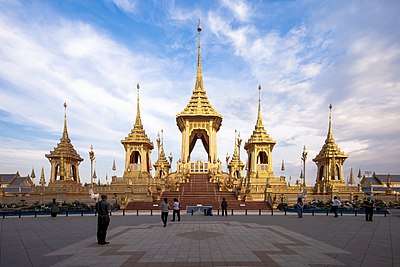Busabok
A busabok (Thai: บุษบก, RTGS: butsabok) is a small open structure used in Thai culture as a throne for the monarch or for the enshrinement of Buddha images or other sacred objects. It is square-based and open-sided, usually with twelve indented corners, with four posts supporting a roughly pyramidal multi-tiered roof culminating in a pointed spire, and usually richly decorated. The structure of the multi-tiered roof is very similar, but much smaller in size, to the mondop architectural form.[1][2][3] The term is derived from the Sanskrit word puṣpaka, a reference to the Pushpaka Vimana, a flying chariot from the Hindu epic Ramayana (and the Thai version Ramakien).[4]
Busabok are used for royal thrones, including the Busabok Mala Throne in the Amarin Winitchai Throne Hall of the Grand Palace,[5] as well as the thrones used ceremonially in royal barge processions.[6] Smaller busabok are used to house objects associated with the king—an early documented example was used to carry the royal letter of King Narai to Louis XIV in the 1686 Siamese embassy to France.[7] Busabok are also used as shrines housing Buddha images, notably the Emerald Buddha in Wat Phra Kaew and Phra Phuttha Sihing at the Bangkok National Museum. Very large versions have formed the design of the temporary crematoria used for royal funerals of previous kings.[8] The busabok was also the basis for a style of Buddhist pulpit known as thammat yot or busabok thammat.[9]
Gallery
.jpg) Busabok Mala Throne (rear-left)
Busabok Mala Throne (rear-left) Royal Barge Anantanakkharat
Royal Barge Anantanakkharat French engraving of the 1686 embassy
French engraving of the 1686 embassy.jpg) Phra Phuttha Sihing
Phra Phuttha Sihing Royal crematorium of King Bhumibol Adulyadej
Royal crematorium of King Bhumibol Adulyadej Royal funeral carriage Maha Phichai Ratcharot
Royal funeral carriage Maha Phichai Ratcharot
References
| Wikimedia Commons has media related to Butsabok. |
- Chaturachinda, Gwyneth; Krishnamurty, Sunanda; Tabtiang, Pauline W. (2004). Dictionary of South & Southeast Asian Art. Silkworm Books. ISBN 1943932158.
- "Thammas: The preaching seat". Muang Boran. 14. 1988.
- สมใจ นิ่มเล็ก (12 September 2019). "เหตุใดสถาปัตยกรรมไทยจึงมีการ "ย่อมุม"". Silpa Wattanatham (in Thai). Retrieved 7 May 2020. Originally published in Silpa Wattanatham. September 2013. Missing or empty
|title=(help) - Sugondhabhirom, Apirat (31 October 2017). "Bidding farewell to a king: Memorial Service for the Royal Cremation of His Majesty the Late King Bhumibol Adulyadej of Thailand". newdelhi.thaiembassy.org. Royal Thai Embassy, New Delhi. Retrieved 8 May 2020.
- Sthapitanond, Nithi; Mertens, Brian (2012). Architecture of Thailand: A Guide to Tradition and Contemporary Forms. Didier Millet. p. 126. ISBN 9789814260862.
- "ทร.ซ้อมใหญ่เชิญเรือพระที่นั่งสุพรรณหงส์ เพื่อใช้ในพระราชพิธีบรมราชาภิเษกฯ". Manager Online (in Thai). 30 April 2019. Retrieved 8 May 2020.
- Kisluk-Grosheide, Daniëlle; Rondot, Bertrand (2018). Visitors to Versailles: From Louis XIV to the French Revolution. Metropolitan Museum of Art. p. 155. ISBN 9781588396228.
- Svasti, Pichaya (5 June 2017). "A beautiful responsibility". Bangkok Post. Retrieved 8 May 2020.
- Dansilp, Tanistha (2012). Things Thai: Antiques, Crafts, Collectibles. Tuttle Pub. ISBN 9781462906055.